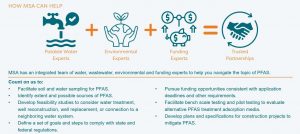PFAS Facts & Concerns
Per- and polyfluoroalkyl substances (PFAS) are a category of thousands of man-made chemicals that have been used since the 1940s for a variety of consumer and industrial applications such as oil- and stain-resistant coatings, packaging, non-stick surface agents, adhesives, and fire suppressants.
The U.S. Environmental Protection Agency (EPA) has conducted comprehensive studies on certain PFAS compounds. The findings reveal that PFAS are widely used and long-lasting “forever chemicals” that persist in water, air, soil, fish, and other animals — and in humans who consume PFAS. PFAS have been linked to adverse health effects, which is prompting the EPA to introduce new regulations to test for and mitigate the presence of PFAS in drinking water.
New Drinking Water Regulations

On April 10, 2024, the EPA finalized its regulations for PFAS in drinking water. These regulations will apply to municipal water systems, other-than-municipal water systems (e.g. mobile home parks), and non-community non-transient water systems (e.g. schools). This National Primary Drinking Water Regulation (NPDWR) will establish legally enforceable Maximum Contaminant Levels (MCLs) for six PFAS found in drinking water — the first federal rule of its kind. The individual states will be required to adopt drinking water PFAS regulations at least as stringent as the federal standards.
What should communities know about the new regulations?
The new PFAS standards are stringent, with maximum contaminant levels set at 4 to 10 parts per trillion for the individual PFAS compounds regulated. If PFAS are detected in drinking water systems at or above the regulatory limits, the water system owner will be required to take action to reduce the PFAS concentrations, inform the public, and perform ongoing monitoring.
Available Funding

State and federal funding is available now to help impacted water systems mitigate PFAS through water treatment, well reconstruction, well replacement, or connection to a neighboring water system. In conjunction with the new EPA regulations, $1 billion in additional funding has been made available through the Bipartisan Infrastructure Law, resulting in current total federal appropriations of $21 billion to address PFAS in the environment. The available funding programs, amount of funding awarded to any single project, and funding application requirements and deadlines vary from state to state. As with PFAS regulations, the funding programs in each state continue to be developed and revised. The funding availability will vary over time based on federal and state legislation. Regardless of the source, obtaining funding will be highly competitive due to the large demand. The owners of water systems impacted by PFAS need to get organized and act early if they hope to maximize their opportunity to secure the most favorable funding package.
How Communities Can Prepare
A good first step is for communities to test their drinking water supply sources for PFAS (or continue sampling per state requirements). If PFAS are detected at any level, the PFAS concentrations should be evaluated with respect to drinking water standards. Where PFAS concentrations are determined to be unacceptable, communities should develop a planning document that evaluates PFAS mitigation options; identifies timelines to meet regulations; identifies available funding programs and deadlines for applying for funds; and provides for public notification and education. Being proactive is key. Communities that act early to understand and document the full scope of their PFAS issues and options for mitigating PFAS will be better positioned to secure the funding they need to address PFAS in a timely and affordable manner.
How MSA Can Help

For more information, reach out to MSA’s panel of PFAS experts at pfas@msa-ps.com.